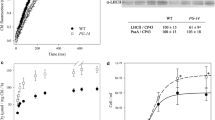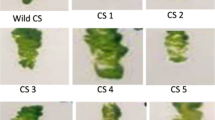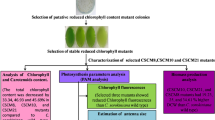Abstract
Microalgae have been proposed as eco-friendly feedstocks for biodiesel production, because they accumulate large amounts of lipids and increase their biomass through photosynthesis. However, the photosynthetic efficiency of microalgae is too low for this strategy to be economically feasible. In an effort to overcome this issue, random mutants with reduced chlorophyll antenna size were generated by ethyl methanesulfonate (EMS)-mediated mutagenesis of Chlorella vulgaris. The antenna size mutant, herein designated E5, exhibited 56.5 and 75.8 % decreases in chlorophyll a and b contents, respectively, with significant reductions in the expression levels of peripheral light-harvesting antenna proteins in photosystem II. The saturated photosynthetic activity and electron transport rate of the E5 mutant were significantly higher and also showed reduced non-photochemical quenching (NPQ), compared to those of the wild type. Consequentially, the E5 mutant cultures achieved 44.5 % improvement in biomass productivity under high light (200 μmol photons m−2 s−1). These results suggest that improving the photosynthetic efficiency of microalgae could greatly enhance their biomass production, and such mutant strains can be applicable for large-scale outdoor cultivation which is typically exposed to high light intensity.





Similar content being viewed by others
References
Andersson J, Wentworth M, Walters RG, Howard CA, Ruban AV, Horton P, Jansson S (2003) Absence of the Lhcb1 and Lhcb2 proteins of the light-harvesting complex of photosystem II—effects on photosynthesis, grana stacking and fitness. Plant J 35:350–361
Beckmann J, Lehr F, Finazzi G, Hankamer B, Posten C, Wobbe L, Kruse O (2009) Improvement of light to biomass conversion by de-regulation of light-harvesting protein translation in Chlamydomonas reinhardtii. J Biotech 142:70–77
Berteotti S, Ballottari M, Bassi R (2016) Increased biomass productivity in green algae by tuning non-photochemical quenching. Sci Rep 6:21339
Cazzaniga S, Dall’Osto L, Szaub J, Scibilia L, Ballottari M, Purton S, Bassi R (2014) Domestication of the green alga Chlorella sorokiniana: reduction of antenna size improves light-use efficiency in a photobioreactor. Biotechnol Biofuels 7:157
Chisti Y (2007) Biodiesel from microalgae. Biotech Adv 25:294–306
Dau H, Zaharieva I, Haumann M (2012) Recent developments in research on water oxidation by photosystem II. Curr Opin Chem Biol 16:3–10
de Bianchi S, Betterle N, Kouril R, Cazzaniga S, Boekema E, Bassi R, Dall'Osto L (2011) Arabidopsis mutants deleted in the light-harvesting protein Lhcb4 have a disrupted photosystem II macrostructure and are defective in photoprotection. Plant Cell 23:2659–2679
Drop B, Webber-Birungi M, Yadav SK, Filipowicz-Szymanska A, Fusetti F, Boekema EJ, Croce R (2014) Light-harvesting complex II (LHCII) and its supramolecular organization in Chlamydomonas reinhardtii. Biochim Biophys Acta Bioenerg 1837:63–72
Gorman DS, Levine R (1965) Cytochrome f and plastocyanin: their sequence in the photosynthetic electron transport chain of Chlamydomonas reinhardi. Proc Natl Acad Sci U S A 54:1665
Hankamer B, Nield J, Zheleva D, Boekema E, Jansson S, Barber J (1997) Isolation and biochemical characterization of monomeric and dimeric photosystem II complexes from spinach and their relevance to the organisation of photosystem II in vivo. Eur J Biochem 243:422–429
Kim CW, Sung MG, Nam K, Moon M, Kwon JH, Yang JW (2014) Effect of monochromatic illumination on lipid accumulation of Nannochloropsis gaditana under continuous cultivation. Bioresour Technol 159:30–35
Kirst H, Garcia-Cerdan JG, Zurbriggen A, Melis A (2012a) Assembly of the light-harvesting chlorophyll antenna in the green alga Chlamydomonas reinhardtii requires expression of the TLA2-CpFTSY gene. Plant Physiol 158:930–945
Kirst H, Garcia-Cerdan JG, Zurbriggen A, Ruehle T, Melis A (2012b) Truncated photosystem chlorophyll antenna size in the green microalga Chlamydomonas reinhardtii upon deletion of the TLA3-CpSRP43 gene. Plant Physiol 160:2251–2260
Kok B (1953) Algal culture from laboratory to pilot plant. In: Burlew JS (ed) Experiments on photosynthesis by Chlorella in flashing light. Carnegie Institution of Washington, Publication 600, Washington, DC, pp 63–75
Kühlbrandt W (1994) Structure and function of the plant light-harvesting complex, LHC-II. Curr Opin Struct Biol 4:519–528
Lea-Smith DJ, Bombelli P, Dennis JS, Scott SA, Smith AG, Howe CJ (2014) Phycobilisome-deficient strains of Synechocystis sp. PCC 6803 have reduced size and require carbon-limiting conditions to exhibit enhanced productivity. Plant Physiol 165:705–714
Mallick N, Mandal S, Singh AK, Bishai M, Dash A (2012) Green microalga Chlorella vulgaris as a potential feedstock for biodiesel. J Chem Technol Biotechnol 87:137–145
Melis A (1991) Dynamics of photosynthetic membrane composition and function. Biochim Biophys Acta Bioenerg 1058:87–106
Melis A (2009) Solar energy conversion efficiencies in photosynthesis: minimizing the chlorophyll antennae to maximize efficiency. Plant Sci 177:272–280
Melis A, Neidhardt J, Benemann JR (1999) Dunaliella salina (Chlorophyta) with small chlorophyll antenna sizes exhibit higher photosynthetic productivities and photon use efficiencies than normally pigmented cells. J Appl Phycol 10:515–525
Müller P, Li X-P, Niyogi KK (2001) Non-photochemical quenching. A response to excess light energy. Plant Physiol 125:1558–1566
Mussgnug JH, Wobbe L, Elles I, Claus C, Hamilton M, Fink A, Kahmann U, Kapazoglou A, Mullineaux CW, Hippler M, Nickelsen J, Nixon PJ, Kruse O (2005) NAB1 is an RNA binding protein involved in the light-regulated differential expression of the light-harvesting antenna of Chlamydomonas reinhardtii. Plant Cell 17:3409–3421
Nakajima Y, Ueda R (1997) Improvement of photosynthesis in dense microalgal suspension by reduction of light harvesting pigments. J Appl Phycol 9:503–510
Nakajima Y, Ueda R (1999) Improvement of microalgal photosynthetic productivity by reducing the content of light harvesting pigment. J Appl Phycol 11:195–201
Nakajima Y, Tsuzuki M, Ueda R (1998) Reduced photoinhibition of a phycocyanin-deficient mutant of Synechocystis PCC 6714. J Appl Phycol 10:447–452
Perrine Z, Negi S, Sayre RT (2012) Optimization of photosynthetic light energy utilization by microalgae. Algal Res 1:134–142
Platt T, Gallegos CL, Harrison WG (1980) Photoinhibition of photosynthesis in natural assemblages of marine-phytoplankton. J Mar Res 38:687–701
Polle JEW, Kanakagiri S, Jin E, Masuda T, Melis A (2002) Truncated chlorophyll antenna size of the photosystems—a practical method to improve microalgal productivity and hydrogen production in mass culture. Int J Hydrog Energy 27:1257–1264
Polle JE, Kanakagiri SD, Melis A (2003) tla1, a DNA insertional transformant of the green alga Chlamydomonas reinhardtii with a truncated light-harvesting chlorophyll antenna size. Planta 217:49–59
Rippka R, Deruelles J, Waterbury JB, Herdman M, Stanier RY (1979) Generic assignments, strain histories and properties of pure cultures of cyanobacteria. J Gen Microbiol 111:1–61
Schenk PM, Thomas-Hall SR, Stephens E, Marx UC, Mussgnug JH, Posten C, Kruse O, Hankamer B (2008) Second generation biofuels: high-efficiency microalgae for biodiesel production. BioEnergy Res 1:20–43
Schreiber U, Klughammer C (2013) Wavelength-dependent photodamage to Chlorella investigated with a new type of multi-color PAM chlorophyll fluorometer. Photosynth Res 114:165–177
Schreiber U, Klughammer C, Kolbowski J (2012) Assessment of wavelength-dependent parameters of photosynthetic electron transport with a new type of multi-color PAM chlorophyll fluorometer. Photosynth Res 113:127–144
Tillich UM, Lehmann S, Schulze K, Duhring U, Frohme M (2012) The optimal mutagen dosage to induce point-mutations in Synechocystis sp. PCC6803 and its application to promote temperature tolerance. PLoS One 7(11):e49467
Wellburn AR (1994) The spectral determination of chlorophylls a and b, as well as total carotenoids, using various solvents with spectrophotometers of different resolution. J Plant Physiol 144:307–313
Work VH, D'Adamo S, Radakovits R, Jinkerson RE, Posewitz MC (2012) Improving photosynthesis and metabolic networks for the competitive production of phototroph-derived biofuels. Curr Opin Biotech 23:290–297
Acknowledgments
This work was supported by a grant from the Advanced Biomass R&D Center (ABC) of Global Frontier Project, funded by the Ministry of Science, ICT and Future Planning (ABC-2010-0029728 and 2011–0031350) and a grant from the Basic Science Research Program through the National Research Foundation of Korea (NRF), funded by the Ministry of Science, ICT and Future Planning (2015R1C1A1A01054303).
Author information
Authors and Affiliations
Corresponding author
Additional information
Won-Sub Shin and Bongsoo Lee contributed equally to this work.
Electronic supplementary material
Below is the link to the electronic supplementary material.
ESM 1
(DOCX 1145 kb)
Rights and permissions
About this article
Cite this article
Shin, WS., Lee, B., Jeong, Br. et al. Truncated light-harvesting chlorophyll antenna size in Chlorella vulgaris improves biomass productivity. J Appl Phycol 28, 3193–3202 (2016). https://doi.org/10.1007/s10811-016-0874-8
Received:
Revised:
Accepted:
Published:
Issue Date:
DOI: https://doi.org/10.1007/s10811-016-0874-8




